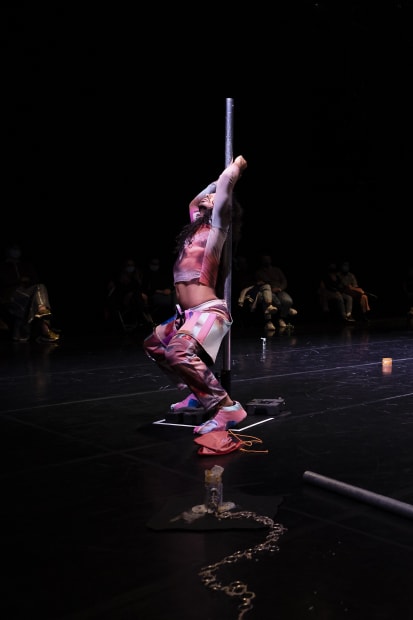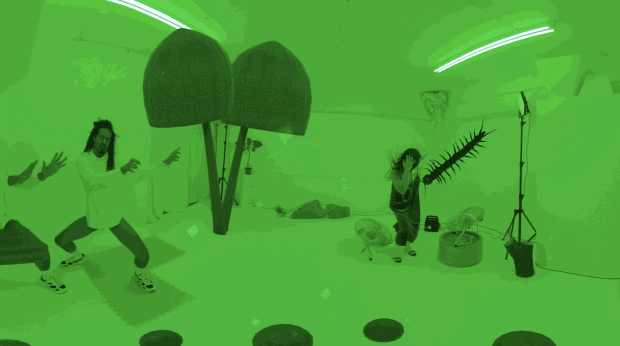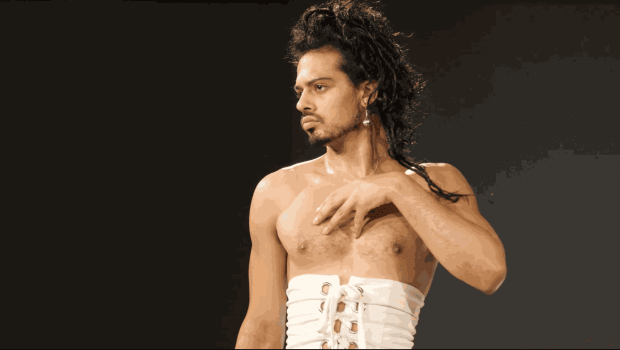-
ADHAM FARAMAWY & JOSEPH FUNNELL
IN CONVERSATION -
Adham Faramawy: I first met Joseph Funnell through choreographer Holly Blakey at a party, after watching her show 'Cowpuncher.' We clicked, we talked and laughed and danced, and I kept up with their performance work until there was an opportunity for us to work together. We’ve now worked together on three videos, which have been seen in screenings at Tate Britain and Vdrome in conjunction with Serpentine Gallery, and installed as part of sculptural installations at Science Gallery and Somerset House, and I’m hoping we’ll make some performance work together for Art Night this summer too. I can’t imagine my most recent work without Joseph’s generosity of movement and choreographic ideas.
-

Rubby Sucky Forge, The Place, Eve Stainton with Joseph Funnell and Gaby Agis, 2020, Photo credit © Anne Tetzlaf
-

Rubby Sucky Forge, The Place, Eve Stainton with Joseph Funnell and Gaby Agis, 2020, Photo credit © Anne Tetzlaf
-

Rubby Sucky Forge, The Place, Eve Stainton with Joseph Funnell and Gaby Agis, 2020, Photo credit © Anne Tetzlaf
-

Rubby Sucky Forge, The Place, Eve Stainton with Joseph Funnell and Gaby Agis, 2020, Photo credit © Anne Tetzlaf
-
Nothing really compares to a process that accumulates traces of each participant's corporeal and conceptual offerings, where you collectively birth something you didn't know could exist prior.
Joseph Funnell
-

Rubby Sucky Forge, The Place, Eve Stainton with Joseph Funnell and Gaby Agis, 2020, Photo credit © Anne Tetzlaf
-

Hurakan Caress, Joseph Funnell & Carlos Maria Romero (aka Atabey Mamasita), Cell Project Space, 2020
-
brown paintings for renaissance masters, Steakhouse Live – Slow Sunday, 2020 | Photo credit © Greg Goodale
-

brown paintings for renaissance masters, Steakhouse Live – Slow Sunday, 2020, Photo credit © Greg Goodale
-

brown paintings for renaissance masters, Steakhouse Live – Slow Sunday, 2020, Photo credit © Greg Goodale
-

brown paintings for renaissance masters, Steakhouse Live – Slow Sunday, 2020, Photo credit © Greg Goodale
-

brown paintings for renaissance masters, Steakhouse Live – Slow Sunday, 2020, Photo credit © Greg Goodale
-
I’m having to make distinctions between creating work to uplift our communities and work that’s purpose is to challenge the oppressive gaze that is embedded in our practices of cultural consumption.
JOSEPH FUNNELL
-
JF: Crucially, I’m interested in employing somatic research and explorations of sensuality, presence, the transformative possibilities of affect, and the radical potential of embodiment through movement. I’m considering whether it is still possible for me as a performer to find agency amongst all of this.
To this point I’m really intrigued by a proposition made by Malik Gaines in their assessment of icon, mother, goddess, visionary and indelible inspiration Nina Simone: the idea that she is performing agency whilst acknowledging that the structural conditions negate that as a true possibility. I think I’m beginning to move away from this but a big preoccupation of mine has been whether there is emancipatory potential in this model.
AF: So much of what we talk about could be reductively termed as identity politics. We’ve talked privately about my feelings about the idea of representation being an end in its own right, but I just don’t see the point of representation unless it contributes to changes in political policy, unless it starts to change the rules and the conditions we live under.
For me identity politics was always a project about the redistribution of wealth. To that end, I want to talk a bit about the idea of having parts of a practice that aren’t necessarily visible to an audience, for example community building and activist work. I know this goes counter to what you just said but I wondered if you’d be ok to talk a bit about the volunteering you do? It feels important to share both the cause and the experience, and do you see volunteering, teaching and performance as separate?
-

My fingers distended as honey dripped from your lips and we danced in a circular motion, video, 15 minutes 20 seconds, Adham Faramawy, performers: Joseph Funnell, Fil Li, Owen Ridley-DeMonick, Eve Stainton, 2019
-

My fingers distended as honey dripped from your lips and we danced in a circular motion, video, 15 minutes 20 seconds, Adham Faramawy, performers: Joseph Funnell, Fil Li, Owen Ridley-DeMonick, Eve Stainton, 2019
-
JF: For the past few years, I’ve been increasingly devoting my energy to migrants rights activism with LGSM (Lesbians and Gays Support the Migrants) and direct support and advocacy work with Southwark Day Center for Asylum Seekers. As you begin to learn about the depth and scale of sheer cruelty, injustice and hypocrisy that this government actively encodes into policy as part of the hostile environment, it’s hard not to be drawn into doing more.
I see this work as quite separate to my artistic practice, and tbh ultimately more important, but they are both grounded in the same ethic and stem from a conscious awareness of the historic conditions that produce circumstances of prejudice and material inequality. Namely, a history of theft and the hoarding of resources by the UK, and the creation of borders to preclude equitable or reparatory access to those resources by people from previously colonized lands.
-

My fingers distended as honey dripped from your lips and we danced in a circular motion, video, 15 minutes 20 seconds, Adham Faramawy, performers: Joseph Funnell, Fil Li, Owen Ridley-DeMonick, Eve Stainton, 2019
-
If we leave activism and advocacy to those who hold optimal power and privilege then nothing will ever happen.
JOSEPH FUNNELL
-
JF: If we leave activism and advocacy to those who hold optimal power and privilege then nothing will ever happen. Like surely that is the fundamental problem no? To remain within the ivory tower espousing rhetoric whilst doing nothing tangible to support other oppressed groups is just not an option for me. If my liberation still sits amongst inequality and the oppression of others it is not liberation, it is just another form of oppression. Migrants and asylum seekers have become one of the demonized groups in society, especially in the UK.
A disproportionately right wing press pander to this nation’s deeply rooted xenophobia whilst the government have spent 10 years pandering to this xenophobia and racism for their own political gain. Recently with LGSM we’ve been focusing on campaigning to close the Napier and Penally Barracks - these are filthy, disused, pre-demolition ex-army accommodation blocks which have been out of action for up to 15 years and have been used to forcibly house (essentially detain) asylum seekers who just risked their lives crossing the English Channel after fleeing war and persecution.
At the height of the pandemic, residents have been forced to sleep in communal blocks alongside strangers, with no opportunity to social distance or self-isolate, and no access to adequate healthcare. Napier barracks in Kent experienced a Covid-19 outbreak, with almost 200 people testing positive. Appalling conditions including sustained electricity and heating outages, a lack of drinking water, blocked toilets, broken plumbing, one shower between 34 people etc. all led to protests, suicide attempts, and a serious fire. Priti Patel has the nerve to blame the COVID outbreak on the residents and claim it’s an insult to the taxpayer and ‘our brave soldiers’ to suggest the accommodation is inadequate.
Meanwhile, leaked documents show that the Home Office purposely chose this scenario so that they wouldn’t look soft on immigration. This is just a snapshot of what is going on. It’s getting worse and will continue to do so. As the climate crisis worsens, what has been termed the present ‘migrant crisis’ will look minor in comparison. Get clued up and get involved if you can! My experience doing direct support work hasn’t always been totally easy, but it puts your life into perspective and working with others in a community of care is a privilege to be cherished.
-

My fingers distended as honey dripped from your lips and we danced in a circular motion, video, 15 minutes 20 seconds, Adham Faramawy, performers: Joseph Funnell, Fil Li, Owen Ridley-DeMonick, Eve Stainton, 2019
-

My fingers distended as honey dripped from your lips and we danced in a circular motion, video, 15 minutes 20 seconds, Adham Faramawy, performers: Joseph Funnell, Fil Li, Owen Ridley-DeMonick, Eve Stainton, 2019
-
Skin Flick, (production stills) video, 13 minutes 30 seconds, Adham Faramawy, performers: Peter Babbage, Joseph Funnell and Luke Hornsby, 2019
-

Skin Flick, (production still) video, 13 minutes 30 seconds, Adham Faramawy, 2019, performers, Peter Babbage, Joseph Funnell and Luke Hornsby
-

Skin Flick, (production still) video, 13 minutes 30 seconds, Adham Faramawy, 2019, performers, Peter Babbage, Joseph Funnell and Luke Hornsby
-



























